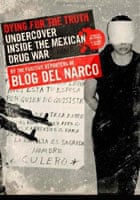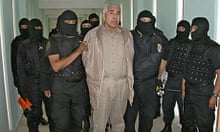For three years it has chronicled Mexico's drug war with graphic images and shocking stories that few others dare show, drawing millions of readers, acclaim, denunciations – and speculation about its author's identity.
Blog del Narco, an internet sensation dubbed a "front-row seat" to Mexico's agony over drugs, has become a must-read for authorities, drug gangs and ordinary people because it lays bare, day after day, the horrific violence censored by the mainstream media.
The anonymous author has been a source of mystery, with Mexico wondering who he is and his motivation for such risky reporting.
Now in their first major interview since launching the blog, the author has spoken to the Guardian and the Texas Observer – and has revealed that she is, in fact, a young woman.
"I don't think people ever imagined it was a woman doing this," said the blogger, who asked to use pseudonym Lucy to protect her real identity.
"Who am I? I'm in my mid-20s, I live in northern Mexico, I'm a journalist. I'm a woman, I'm single, I have no children. And I love Mexico."
This is the first time Lucy has spoken directly about the motivations for running a blog which could cost her her life. In the early days, her male colleague who manages the technical side engaged in a few short, anonymous email exchanges with reporters, but neither has spoken out since.
The telephone interview was arranged through an anonymous intermediary. The Guardian then took steps to verify that Lucy was in control of the blog.
She said she wanted to show the truth of what was happening to help turn the page. "I'm in love with my culture, with my country, despite all that's going on. Because we're not all bad. We're not all narcos. We're not all corrupt. We're not all murderers. We are well educated, even if many (foreign) people think otherwise."
She and her colleague live in daily fear of retribution, either from the cartels or government forces. She revealed that a young man and woman tortured, disembowelled and hung from a bridge in September 2011 – murders which shocked even atrocity-hardened Mexicans – were collaborators on the blog. "They used to send us photographs. That was very hard, very painful." The threats, she said, have recently become more serious.

Despite those fears, however, Lucy has written a book that gives an inside account of the blog and provides the most gruesome, explicit account yet of the mayhem that the cartel wars have brought to Mexico. Dying for the Truth: Undercover Inside Mexico's Violent Drug War, is now on sale in English and Spanish, and documents a full year of killings from 2010, a pivotal year.
"I did the book to show what was happening," she said. "When I finished, I was able to breathe, because I had worried about being killed before finishing. But the book is there, it's there on paper, a testament to what we have suffered in Mexico in these years of war."
Adam Parfrey, head of the independent Washington-based publisher Feral House, which specialises in taboo topics, said the book would be bound in a police-tape type band as warning of its contents. "It's gruesome and horrible. It goes far beyond anything I've ever dealt with. It's an important element of what's happening in our southern neighbour."
The inside account of Blog del Narco comes at a sensitive time. President Barack Obama is due to visit Mexico in early May for talks with his counterpart, Enrique Peña Nieto, who since taking office last December has tamped down confrontations with the drug lords and the ensuing media attention.
Even so, drug-related violence claimed nearly 3,200 lives in his administration's first three months, according to government figures, and in recent weeks killings have spiked along the border, and even in the tourist city of Cancún. Cartels are increasingly sending agents to live and work in US cities such as Chicago, according to a recent AP investigation.
The legalisation of marijuana in Colorado and Washington has intensified pressure on the US government to review its four-decade-old "war" on marijuana, cocaine and other narcotics, much of it trafficked through Mexico.
After President Felipe Calderón declared his own war on Mexico's drug cartels in 2006, sparking turf battles between groups like Sinaloa, La Línea and the Zetas, and bloody interventions by the police and armed forces, who have been accused of siding with criminals. More than 70,000 people died and 27,000 disappeared by the time he finished his term last year.
Intimidation of journalists – dozens have been murdered, often sadistically – neutered news coverage by newspapers, radio and television stations. Massacres, kidnappings, corruption, even pitched battles in city centres, often went unreported.
Blog del Narco sprang up three years ago to fill the vacuum left by cowed journalistic colleagues who could not even report vital information such as narco roadblocks and kidnappings.
Over time, Blog del Narco acquired multiple sources, including drug gangs, and became indispensable reading, drawing more than 3m hits monthly. It provides bulletins, pictures and video of abductions, shootouts, executions and the discovery of bodies as well as severed human heads, limbs and torsos. One video showed cartel members interrogating a captured rival and then decapitating him.
Critics accuse the blog of being a public relations forum for drug dealers, but Lucy said the material showed reality and helped families identify missing relatives. "If it wasn't for the blog often bodies wouldn't be identified."
Narcos occasionally sent photos of them partying with pop stars, but the blog refused to publish such material, she said. The blog takes advertising from car and mobile-phone makers, among others. Lucy has told no friends about her clandestine activity. "My close family knows. No one else."
The blog had come under repeated cyber-attack – the government was more aggressive than narcos in this regard, Lucy said – but the main concern was being identified and captured, either by narcos or government forces who have been accused of multiple abuses.
"We change where we live every month. We've been in basements. It's very difficult. We hide our equipment in different places. If the authorities get close we run."
A sign left by the young couple disembowelled in 2011 in the state of Tamaulipas said the bloggers were next. Lucy had not met the couple but received material from them via email. A few days later, another contributor was killed. A keyboard, mouse and sign mentioning the blog were strewn over the corpse. "It's very painful. But they believed this work was necessary."
Lucy said it was too soon to judge Peña Nieto's administration but that she had already noted one change. In contrast to Calderón-era officials, who cowed journalists with threats and bribes, the new government appeared to want to do it through repressive laws, she said. The government denies wanting to stifle the media.
"We have thought about quitting the blog thousands of times. But we haven't, because we have to get the message out. They have stolen our tranquility, our dreams, our peace." Lucy said she was tired of living in fear but had no plans to give up the blog. It has spawned other anonymous blogs carrying similar material.
The revelation she was female would surprise many, said Lucy. "It's a strong blow to Mexican machismo and the idea women are weaker, more delicate. There is an expectation for women to always look pretty. But we're much more than that."
She tried to relax, she said, with music, coffee and cigarettes. She missed having a normal life. "My only boyfriend is the blog. A whole phase of my life – boyfriends, going to parties, hanging out with friends – I've missed it. Getting married, having babies – there's not been time to think of any of that."
Lucy hoped the book, which focuses on 2010 and 2011, will stand as a historical record. In addition to stomach-turning photographs, it includes a glossary of terms such as encintado – the binding of a victim with duct tape – and encobijado – wrapping a murdered person in a blanket or sheet. It will initially be on sale only in the US but the publisher, Feral House, hopes Mexican booksellers will stock it.
Lucy said she had recently take a paying job but would continue the blog.
"My plans for the future? To live. That's my hope for the short, medium and long term."

This article was reported in partnership with the Texas Observer







Comments (…)
Sign in or create your Guardian account to join the discussion